Abstract
To explore the feasibility of renewable hybrid energy systems for expressway infrastructure, this study proposes a scenario-based design methodology integrating solar, wind, and hydropower resources within the expressway corridor. A case study was conducted on a highway service area located in southern China, where a solar/wind/hydro hybrid energy system was developed based on the proposed approach. Using the HOMER Pro 3.14 software platform, the system was simulated and optimized under off-grid conditions, and a sensitivity analysis was conducted to evaluate performance variability. The results demonstrate that the strategic integration of corridor-based natural resources—solar irradiance, wind energy, and hydrodynamic potential—enables the construction of a technically and economically viable hybrid energy system. The system includes 382 kW of PV, 210 kW of wind, 80 kW of hydrokinetic power, a 500 kW diesel generator, and 180 kWh of battery storage, forming a hybrid configuration for a stable and reliable energy supply. The optimized configuration can supply up to 1,095,920 kWh of electricity annually at a minimum levelized cost of energy of USD 0.22/kWh. This system reduces CO2 emissions by 23.2 tons/year and NOx emissions by 23 kg/year. demonstrating strong environmental performance and long-term sustainability potential.
1. Introduction
With the continuous expansion in national economies, the total length of expressway networks has been growing rapidly, leading to substantial energy consumption across transportation infrastructure. Recent studies estimate that the annual electricity demand of expressway facilities in China alone reaches approximately 1.799 × 1010 kWh [1]. Currently, most of this demand is met through centralized grid power. However, given the extensive and linear nature of expressway systems, the cost of electricity transmission is exceedingly high, and the heavy reliance on external grids poses critical vulnerabilities; any disruption in the grid can jeopardize the operational continuity of essential highway services. In contrast, expressway corridors possess abundant untapped renewable energy resources such as solar radiation, wind power, and hydropower potential. Harnessing these locally available green resources presents a promising pathway for establishing decentralized, resilient, and sustainable energy systems tailored to highway applications.
The expressway corridor, beyond the bounds of the pavement and subgrade, harbors substantial renewable energy potential. Recent studies have explored various approaches to harness this potential. Liu et al. [2] developed a road-based photovoltaic (PV) capacity prediction model leveraging remote sensing imagery and multi-source geographic information system (GIS) data to estimate urban road solar potential. Ferri et al. [3] evaluated the power generation capabilities of three different PV pavement materials and proposed a transportation shadow model to assess their real-world viability. Duman et al. [4] installed PV systems along roadways to establish an off-grid power supply for LED lighting, finding the system to be low-maintenance, easily deployable, and long-lasting. Rehman et al. [5] introduced a methodology for assessing solar energy potential along electric bus routes, revealing that rooftop PV panels could offset approximately 8.5% of the vehicle’s energy demand. Tian et al. [6] employed three-dimensional computational fluid dynamics (3D CFD) simulations to optimize rotor spacing in highway-deployed wind turbine arrays. Sundaram et al. [7] designed a vertical-axis wind turbine system capable of off-grid operation, specifically intended to power highway lighting infrastructure.
Within the pavement structure itself, additional studies have targeted embedded energy harvesting strategies. Chen et al. [8] proposed a piezoelectric energy harvesting system for roadways, achieving an open-circuit energy density of 15.37 J/(m·pass·lane). Jiang et al. [9] developed a thermoelectric module capable of converting asphalt heat into electrical power while reducing surface temperatures; tests on a 300 mm × 300 mm × 100 mm asphalt block yielded an output voltage of 0.564 V. Azam et al. [10] introduced a speed bump-based energy harvester, which generated a peak power of 11.99 W and a voltage of 20.57 V under a 150 N load at 120 mm/s.
Despite these advancements, research on integrated hybrid energy systems tailored to roadway environments remains limited. The intermittent nature of individual renewable sources—solar PV being ineffective at night and wind power being contingent upon local wind conditions—underscores the need for hybrid configurations that can ensure reliability through complementary resource coupling.
Research on hybrid renewable energy systems has primarily focused on two dimensions: technical configurations and economic performance. On the technical front, Kotb et al. [11] investigated a wind-PV-diesel-battery hybrid system, conducting sensitivity analyses that accounted for load demand, storage costs, and interest rate fluctuations. Vendoti et al. [12] examined an off-grid configuration integrating PV, wind, biomass, biogas, fuel cells, and batteries, evaluating both its technical viability and economic implications. Das et al. [13] analyzed a PV-diesel-pump-hydro storage (PHS) system, using solar radiation, diesel prices, PHS costs, and interest rates as key sensitivity variables. Azerefegn et al. [14] studied a grid-connected diesel-PV-battery system, assessing the impact of solar insolation, PV capital expenditure, grid tariffs, load profiles, fuel prices, and grid outages on system performance.
From an economic standpoint, two primary metrics are commonly used to assess hybrid system viability: net present cost (NPC) and levelized cost of energy (COE). Alotaibi et al. [15] compared off-grid and grid-tied PV-wind-diesel-battery systems and found that incorporating PHS increased overall system cost, with the COE reaching USD 0.34/kWh. Cano et al. [16] proposed a PV-hydrokinetic turbine (HKT)-battery system, which achieved a significantly lower COE of USD 0.182/kWh. Similarly, Li et al. [17] demonstrated that an off-grid PV-wind-biomass system could also achieve a COE of USD 0.182/kWh. Coban et al. [18] reported comparable results for a grid-connected wind-diesel-PV-battery system, further validating the economic potential of such configurations under appropriate conditions.
In summary, while renewable energy systems have been successfully applied across various sectors, demonstrating strong economic viability and technical feasibility, their integration into the transportation domain remains limited. Addressing this gap, the present study proposes a scenario-coupled hybrid renewable energy system tailored to the unique spatial and operational characteristics of expressways. A case study is conducted on a service area along a southern China expressway, where the off-grid applicability of such a system is evaluated. The analysis focuses on both technical performance and economic feasibility for powering critical highway infrastructure nodes through the coordinated use of local solar, wind, and hydropower resources.
2. Methodology for System Configuration
The development of the expressway hybrid renewable energy system began with the selection of suitable energy scenarios along the highway corridor, based on a comprehensive assessment of locally available renewable resources. Subsequently, the HOMER Pro 3.14 software platform was employed to simulate all feasible configurations of hybrid systems by integrating annual load profiles, site-specific resource data, and the technical and economic parameters of the system components. These simulations generated an array of system combinations, which were then ranked according to their cost-effectiveness. Detailed techno-economic analyses are conducted for each configuration to identify the optimal system architecture. Finally, a sensitivity analysis was performed to evaluate the system’s robustness under varying resource and demand conditions. The overall configuration process is illustrated in Figure 1 below:
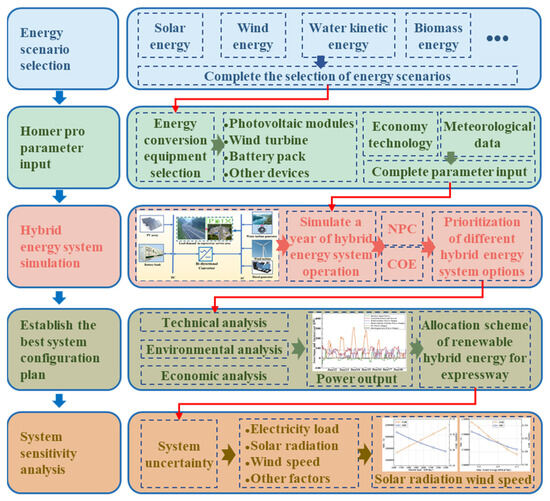
Figure 1.
Flowchart of the construction process for expressway scenario-coupled renewable hybrid energy systems.
2.1. System Parameters for Renewable Hybrid Energy Configuration
The configuration process begins with an assessment of the renewable energy resources available in the expressway region, including solar irradiance, wind potential, hydropower, biogas, and geothermal energy. The most suitable renewable sources were selected based on regional availability and quality. In parallel, supporting datasets were collected, encompassing meteorological (e.g., temperature, solar radiation, wind speed, and water flow velocity), economic, technical, and load demand parameters.
Next, appropriate energy conversion technologies were selected for each resource type. These include PV modules, wind turbines, hydrokinetic generators, and energy storage systems. For each component, technical specifications and economic indicators—such as capital cost, replacement cost, operating and maintenance expenses, and efficiency—were defined based on manufacturer data or validated literature sources.
Finally, system configuration accounted for the project’s planning horizon, typically represented by its operational lifetime, which served as a key input for lifecycle cost and performance assessments.
2.2. Economic Evaluation Metrics
The economic performance of the renewable hybrid energy system was primarily evaluated using two key indicators: NPC and levelized COE.
NPC represented the total lifecycle cost of the system, calculated as the present value of all capital, replacement, operation, and maintenance costs incurred throughout the project’s lifetime, minus the present value of any revenues or salvage values. It reflects the overall financial commitment required to install and operate the system. The NPC was computed using the following equation [19,20,21]:
where CA is the total annualized cost (in USD/year), and The capital recovery factor (CRF) is the capital recovery factor. The CRF was calculated as [22,23]:
where LT is the project lifetime (in years), and i is the real annual interest rate.
COE refers to the average cost per kilowatt-hour (kWh) of electricity generated by the system over its lifetime. It was calculated by dividing the system’s total annualized cost by the total electricity served annually. This metric is widely used to compare the cost-effectiveness of different energy system configurations. The COE is given by the following equation [24,25]:
where Cann,tot is the total annualized cost of the system (in USD/year), and Eserved is the total amount of electricity supplied to the load annually (in kWh/year).
2.3. Environmental Indicators
The environmental assessment of the expressway renewable hybrid energy system included an evaluation of pollutant emissions associated with various system configurations. Specifically, the analysis quantified emissions such as carbon dioxide (CO2), carbon monoxide (CO), sulfur dioxide (SO2), nitrogen oxides (NOx), particulate matter (PM), and hydrocarbons (HC) resulting from system operation, particularly from backup diesel generators.
In addition, the renewable energy penetration rate (Renfrac) was used to assess the share of electricity demand met by renewable sources over the course of a year. It was defined as the ratio of the total renewable electricity generation to the total annual load demand served by the system. The Renfrac was calculated using the following equation [26]:
where Pren is the total annual electricity output from renewable sources (in kWh), and Lserved is the total electricity load served by the system annually (in kWh).
3. Design Principles for Wind/Solar/Hydropower Scenario Configuration
This study focuses on the development of a renewable hybrid energy system tailored to highway corridors under a wind/solar/hydropower resource scenario. The objective is to optimize the utilization of solar, wind, and hydrodynamic energy potentials available within the expressway right-of-way (ROW).
3.1. Site Selection Principles
The site selection process for representative wind/solar/hydropower scenarios is primarily guided by the availability and quality of local renewable energy resources, including solar irradiance, wind potential, and water kinetic energy.
- (1)
- Solar Resource Classification:
In accordance with relevant technical standards, global horizontal irradiation (GHI) is used as the key metric to evaluate solar resource availability. Based on annual total solar radiation levels, four categories—A, B, C, and D—are defined to classify regions by solar potential, as shown in Table 1 [27].

Table 1.
Evaluation Standards for Highway Solar Energy Resource Level.
According to the above classification criteria, priority is given to locations with higher solar resource potential within the available area.
- (2)
- Wind Resource Classification:
In accordance with relevant standards, wind energy zones are classified into four categories—rich, moderately rich, usable, and poor—based on the annual average wind speed measured at a height of 50 m, as shown in Table 2 [28].

Table 2.
Evaluation Standards for Highway Wind Energy Resource Level.
According to the above classification, areas with higher wind energy potential are prioritized within the available zones
- (3)
- Hydropower Resource Classification:
In assessing hydropower potential, the most critical factor is the flow velocity, as the maximum output power of a hydrokinetic turbine is determined by the kinetic energy of the water striking the turbine blades. Taking into account turbine efficiency (η) and installation conditions, the theoretical maximum power output, Pmax, is given by [29]:
where V is the water flow velocity (m/s), Q is the volumetric flow rate through the turbine (m3/s), and ρ is the water density, typically 1030 kg/m3.
where A is the swept area of the turbine blades (m2).
Therefore, when the turbine blade sweep area is denoted as A, and the river’s average flow velocity as V, the maximum output power can be expressed as follows [30]:
Considering other factors that affect turbine performance, the actual power output of hydrokinetic systems is typically lower than the theoretical maximum. Therefore, a system efficiency coefficient Cp (ranging from 0.35 to 0.45) is introduced to account for conversion losses. The practical maximum power output is thus given by:
Based on the above equations, both the water flow velocity and the radius (or swept area) of the hydrokinetic turbine must be considered when evaluating hydropower resources. According to the market data and literature surveys, hydro turbines can begin generating usable electricity when the flow velocity exceeds 1 m/s. Based on this, the classification of water kinetic energy resources is defined as follows in Table 3:

Table 3.
Evaluation Criteria for River Water Kinetic Energy Resource Level.
Within the available areas, priority is given to locations with stable flow velocities and high hydropower potential.
- (4)
- Three-Dimensional Site Selection Principles
A two-dimensional preliminary screening model can be established based on wind resource and solar irradiance classifications, dividing the region into four evaluation levels, as illustrated in Figure 2:
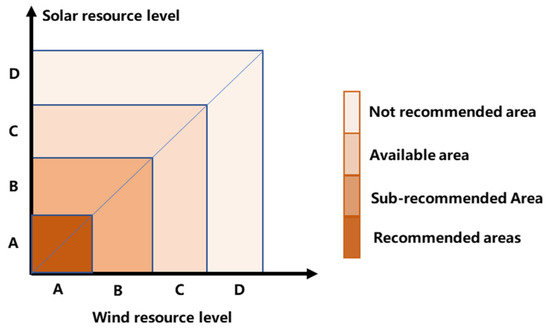
Figure 2.
Preliminary screening of solar irradiance and wind resource levels.
By incorporating the hydropower resource classification as a third dimension into the two-dimensional screening model, a three-dimensional site evaluation framework is established, as shown in Figure 3:
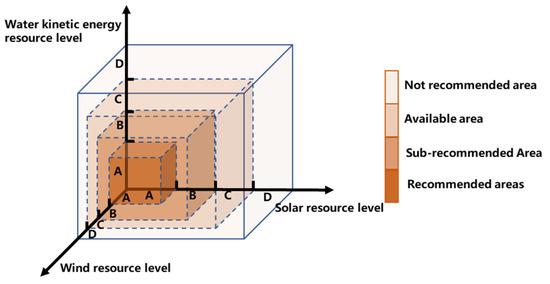
Figure 3.
Integrated screening of hydropower, solar irradiance, and wind resources.
The corresponding three-dimensional evaluation space is divided into four categories:
Tier 1: Recommended Area—All three resources (wind, solar, and hydropower) are classified as rich.
Tier 2: Sub-recommended Area—Wind, solar, and hydropower resources fall into the moderately rich category.
Tier 3: Available area—All three resources are rated as usable but not optimal.
Tier 4: Not Recommended Area—Wind, solar, and hydropower resources are all considered poor.
The selection of a specific wind/solar/hydropower scenario site is determined by its position in the three-dimensional coordinate space (x, y, z), where each axis represents the classification level of one resource type.
- (5)
- Additional Considerations:
Proximity to Load Centers: Priority should be given to locations near major electricity demand nodes, such as service areas, toll stations, and tunnels.
Temperature Sensitivity of Solar Resources: Solar panel performance is highly sensitive to ambient temperature. For silicon-based photovoltaic modules, the optimal operating temperature is 25 °C. Each 1 °C increase in temperature can result in a power loss of approximately 0.35–0.45%. Moreover, temperatures below −20 °C may cause physical damage to PV modules. Thus, the long-term monthly average surface temperatures for both the hottest and coldest months at the site should be considered.
Sufficient Installation Space: Selected sites must have adequate space to accommodate renewable energy conversion equipment (e.g., PV arrays and turbines).
Preference for Larger Usable Areas: Among the feasible locations, those with greater deployable surface area should be prioritized.
Geological Suitability: Locations should possess favorable geological conditions to ensure construction feasibility and structural stability.
In summary, the site selection process for wind/solar/hydropower scenarios must comprehensively integrate the above criteria to ensure the suitability of expressway corridor-based hybrid renewable energy systems.
3.2. Load Demand
Load demand data can be obtained from historical load curves or design specifications of highway energy consumption nodes. When the demand is relatively high, the deployment of hybrid renewable energy systems may be constrained by the available installation area and capital investment. Therefore, it is advisable to classify the types of loads when necessary, and the system should prioritize the supply of critical or essential loads.
3.3. Design of the Wind/Solar/Hydropower Hybrid Energy System for Expressways
Based on the site selection analysis presented in Section 2.1, a renewable hybrid energy system is designed for the target expressway region by integrating wind, solar, and hydropower resources. Due to the intermittent and variable nature of solar and wind energy, the power output from photovoltaic panels, wind turbines, and hydrokinetic generators is inherently unstable. To ensure a reliable and continuous electricity supply, a diesel generator is incorporated as a backup power source. Batteries are included to store excess energy and stabilize voltage at the load terminals, while converters are used to manage power conversion between AC and DC systems. The schematic diagram of the expressway wind/solar/hydropower hybrid energy system is illustrated in Figure 4 below:
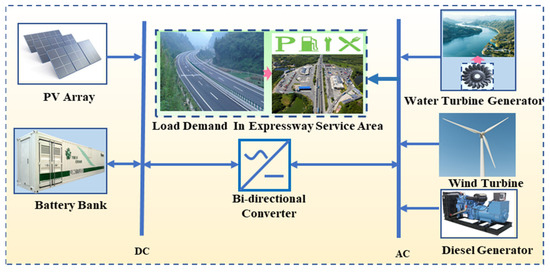
Figure 4.
Schematic diagram of expressway renewable hybrid energy system.
3.4. System Parameters for Renewable Energy Components
During the analysis and system design phase, it is essential to obtain detailed technical and economic parameters of the selected renewable energy conversion technologies, such as wind turbines, PV modules, and hydrokinetic generators. These parameters include device models, purchase prices, service lifespans, and operation and maintenance (O&M) costs. Data can be sourced from the published literature or directly from equipment manufacturers.
4. Results and Discussions
To further demonstrate the practical application of the proposed hybrid energy system design methodology under wind/solar/hydropower scenarios, a case study was conducted at a highway service area in southern China. The site is geographically located at 24°47′12″ N, 110°48′56″ E and is situated adjacent to a riverbank, which offers access to hydropower resources.
4.1. Assessment of Available Renewable Resources in the Wind/Solar/Hydropower Scenario
The selected service area exhibits favorable wind and solar conditions and is close to a river, making it well-suited for hydrokinetic energy harvesting. Resource data—including solar radiation, ambient temperature, wind speed at 50 m, and river flow velocity—were obtained from NASA and engineering survey reports. The data are illustrated in Figure 5:
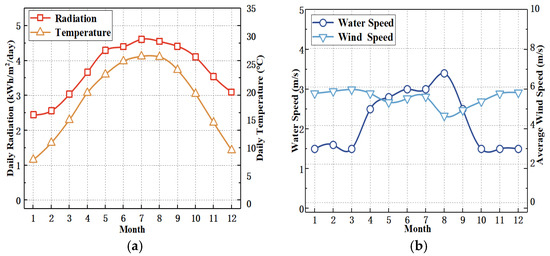
Figure 5.
Data on solar radiation, air temperature, wind speed, and river flow velocity in the case area. (a) Solar Irradiance and Ambient Temperature. (b) Wind Speed and River Flow Velocity.
Wind Resources: As shown in Figure 5b, the annual average wind speed at the study site reaches a peak of 5.87 m/s in March, with a yearly mean of 5.42 m/s, indicating strong potential for wind energy utilization.
Solar Resources: The highest solar irradiance occurs in July, reaching 4.61 kWh/m2/day, while the lowest is observed in January, at 2.44 kWh/m2/day. The annual average solar radiation is 3.72 kWh/m2/day, suggesting that the region has relatively abundant solar energy potential.
Hydropower Resources: The service area is located adjacent to a river, with seasonal variations in flow velocity. During winter, the river current speed averages around 2.0 m/s, increasing to approximately 4.0 m/s during the rainy season, which provides a favorable basis for hydrokinetic energy development.
Ambient Temperature: As shown in Figure 5a, the annual average temperature is 22.10 °C, with the highest temperatures occurring between June and August. This thermal profile is relevant for evaluating solar panel efficiency and durability.
Based on the scenario selection criteria established in Section 2.1 and the assessment of local renewable energy endowment, the site is classified as a “usable area” within the wind/solar/hydropower hybrid framework. Therefore, the deployment of a hybrid renewable energy system utilizing these three sources is considered technically feasible for this expressway location.
4.2. Analysis of Load Demand Data
Actual load data for the service area were obtained from engineering design documentation. Considering the purpose and characteristics of energy consumption in the service zone, the total load is categorized into three distinct types to enable more precise sizing of the hybrid energy system:
Primary loads, including surveillance systems, communication equipment, and lighting;
Fire protection loads, covering all fire safety-related systems;
Residential and commercial loads, such as water pumps, fuel stations, and other service-related utilities.
Given the relatively high total electricity demand of the service area and the limited space available for installing renewable energy equipment, this study focuses on supplying only the primary loads through the hybrid system. The average daily energy requirement for these critical loads is 1641.60 kWh/day. The monthly distribution of this primary load is shown in Figure 6.

Figure 6.
Monthly average distribution of major loads in the service area.
As shown in the figure, electricity demand for primary loads is relatively lower during the summer (June–August) and autumn (September–November) months, and higher in the winter (December–February) and spring (March–May) seasons. This seasonal variation is primarily attributed to fluctuations in lighting demand. While surveillance and communication systems operate continuously throughout the day, lighting systems are typically activated during nighttime hours. The longer daylight duration in summer and autumn reduces lighting energy consumption, whereas shorter days in winter and spring result in increased lighting demand.
4.3. Technical, Economic, and Environmental Analysis of the Hybrid Renewable Energy System
- (1)
- System Parameters for Renewable Energy Components
The technical and economic parameters of the selected system components used in this study were obtained from the published literature and manufacturer specifications. These include data such as component efficiency, rated capacity, capital cost, replacement cost, and O&M costs, as shown in Table 4.

Table 4.
Input Parameters of Hybrid Energy System Components.
- (2)
- Technical Analysis
The hybrid renewable energy system configurations analyzed in this study consist of various combinations of the following components: PV modules, battery storage units, wind turbines, diesel generators, and hydrokinetic turbines. To evaluate the technical feasibility of each configuration, two key performance indicators were used: levelized COE and NPC.
A total of 40,000 system configurations were simulated and optimized using the HOMER Pro 3.14 software platform. The goal was to identify the combinations that minimized both COE and NPC, thereby determining the most technically and economically viable system designs. The results of these optimization analyses are summarized in Table 5 and Table 6.

Table 5.
Optimized Design of Microgrid Proposed.

Table 6.
Capacity Configuration.
The power generation results of 11 different hybrid energy system configurations are illustrated in Figure 7a–k. Each subplot shows the percentage contribution of various power generation devices—solar PV, wind turbines, hydrokinetic turbines, diesel generators, and batteries—within each configuration. The electricity generated by each system serves two primary purposes: supplying power to meet the load demand and storing surplus energy when generation exceeds demand.


Figure 7.
Power generation curve for each renewable hybrid energy system.
Furthermore, a comparative analysis of Figure 8a,b presents the generation–demand relationships for case 2 and case 8 during the same time period in June. The results indicate that the integration of battery storage significantly improves the system’s ability to meet peak load demands, while also reducing the operational runtime of the diesel generator.
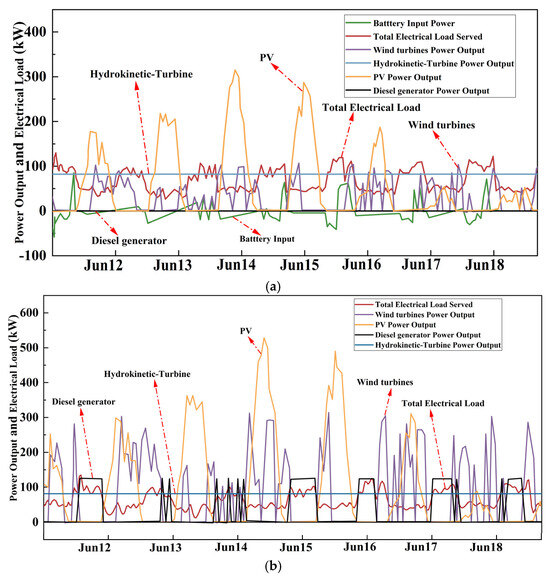
Figure 8.
Power generation and load demand of case 2 and case 8 at the same time in June. (a) Power generation and load demand relationship for case 2. (b) Power generation and load demand relationship for case 8.
- (3)
- Economic Analysis
An economic assessment was conducted for each hybrid renewable energy system configuration. The results are presented in Table 7. Among the evaluated cases, NPC increases progressively from case1 to case7, with case1 exhibiting the lowest NPC of USD 1,709,752, and case7 showing the highest NPC at USD 2,948,775.

Table 7.
Economic Evaluation of Each Renewable Hybrid Energy Option.
In terms of levelized COE, case1 and case2 both achieved the lowest COE at USD 0.22/kWh, followed by case3, which reported a COE of USD 0.24/kWh.
- (4)
- Environmental Analysis
An environmental impact assessment was conducted for each hybrid renewable energy system configuration. The calculated results, including emissions of key pollutants, are summarized in Table 8:

Table 8.
Environmental Impact Assessment for Each Renewable Hybrid Energy Option.
From the table, it can be observed that case1, case5, and case7 achieved zero emissions, as they do not incorporate diesel generators. In contrast, all other configurations involve diesel backup units and consequently produce varying levels of pollutant emissions.
4.4. Selection of the Optimal Hybrid Renewable Energy Configuration
Based on the technical and economic analysis in Section 3.3, case1, case2, and case3 emerged as the top three configurations. In case1, power is primarily generated by solar PV modules, hydrokinetic turbines, wind turbines, and battery storage. While this configuration achieves the lowest NPC, it lacks a diesel generator, which is crucial for ensuring power supply reliability during peak load conditions. The absence of a dispatchable backup source makes case1 operationally vulnerable, and thus it is excluded from final consideration.
Case2, in contrast, integrates PV, wind turbines, hydrokinetic turbines, battery storage, and a diesel generator for backup. It achieves a renewable energy penetration rate of 95.08%, exhibits minimal environmental impact, and delivers superior cost performance with a COE of USD 0.22/kWh and an NPC of USD 1,727,891, outperforming case3. Therefore, case2 is identified as the optimal system configuration.
The annual energy generation breakdown for each component in case2 is shown in Table 9. It reveals that PV contributes the largest share (41%), while the diesel generator accounts for only 3%, highlighting the system’s high reliance on clean energy sources.

Table 9.
Summary of Annual Power Generation of Different Renewable Energy Sources.
4.5. Sensitivity Analysis
In real-world applications, hybrid renewable energy systems are often subject to various uncertainties. In this study, solar irradiance and load demand were selected as sensitivity variables to investigate their impacts on the system’s NPC and levelized COE. The parameters and values used in the sensitivity analysis are summarized in Table 10:

Table 10.
Sensitive Analysis Variables.
- Sensitivity Analysis of Load Demand Growth:
Future expansion of the service area’s energy needs may include fire protection and residential/commercial loads. To account for this potential increase, the sensitivity analysis considers four scenarios where the load demand rises by 10%, 20%, 30%, and 40%, respectively. As illustrated in Figure 9a, the NPC of the hybrid renewable energy system increases with higher load demand, while the levelized COE decreases due to improved system utilization.
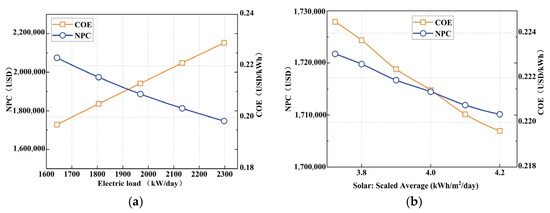
Figure 9.
Effects of load and radiation on NPC and COE in the study area. (a) Load change. (b) Solar radiation change.
- Sensitivity Analysis of Solar Irradiance Variability:
As shown in Figure 9b, both NPC and COE decrease as solar irradiance increases. This highlights the strong influence of solar availability on the economic performance of the hybrid energy system.
5. Conclusions
To address the challenge of low energy utilization efficiency despite abundant natural resources along highway corridors, this study proposes a hybrid renewable energy system design method that integrates wind, solar, and hydrokinetic resources. A comprehensive technical, economic, and environmental feasibility analysis was conducted based on a case study of a service area located in southern China. The key findings are as follows:
- (1)
- A scenario-based hybrid energy system design methodology was proposed for expressways under typical wind/solar/hydropower conditions.
- (2)
- To facilitate effective site selection, a three-dimensional evaluation framework was developed, which enables integrated assessment of wind, solar, and hydropower resource intensities across typical expressway scenarios. This framework allows for the identification of optimal deployment zones based on multi-resource synergies.
- (3)
- A southern China expressway service area was selected as a representative site for simulation-based analysis. The optimal configuration (case2) delivers an annual electricity output of 1,095,920 kWh, with 97% derived from renewable sources and only 3% from the diesel generator.
- (4)
- Sensitivity analysis reveals that increased load demand significantly raises NPC, while higher solar irradiance reduces both NPC and COE. These findings highlight the importance of accounting for future demand growth and climatic variability in the system design process to ensure cost-effectiveness and operational resilience.
In conclusion, the wind/solar/hydropower hybrid energy system designed in this study proves to be technically feasible and economically competitive for highway applications. It enhances the energy self-sufficiency of road infrastructure and reduces dependency on urban power grids. The proposed methodology offers substantial potential for large-scale deployment. Future research may focus on intelligent energy dispatch strategies, grid-interactive operation mechanisms, and adaptive optimization for various highway scenarios using AI-driven approaches.
Author Contributions
Conceptualization, Y.Z. and S.Z. (Song Zhang); methodology, Y.Z.; software, W.H.; validation, M.Y., Z.W., and S.Z. (Song Zhang); formal analysis, Z.C.; investigation, W.H.; resources, M.Y.; data curation, Z.W.; writing—original draft preparation, Y.Z.; writing—review and editing, S.Z. (Shuo Zhang); visualization, W.H.; supervision, M.Y.; project administration, M.Y.; funding acquisition, M.Y. All authors have read and agreed to the published version of the manuscript.
Funding
This research is supported by the Research Project on Integrated Planning, Design, and Comprehensive Benefit Evaluation of Road-Photovoltaic Systems for the Wuwei (Taqiao) to Chaohu (Muji) Section of the Tongshang Expressway (Grant number: 2020-340000-48-02-030729) and the Research and Demonstration Project on Key Technologies for Deep Self-Consistent Utilization of Green Energy in Multiple Highway Scenarios.
Data Availability Statement
The original contributions presented in the study are included in the article; further inquiries can be directed to the corresponding author.
Conflicts of Interest
Muqing Yao, Zunbiao Wang, Song Zhang, and Zhufa Chu were employed by the Anhui Wutong Changjiang Expressway Co., Ltd. The remaining authors declare that the research was conducted in the absence of any commercial or financial relationships that could be construed as a potential conflict of interest.
Abbreviations
The following abbreviations are used in this manuscript:
| PV | Photovoltaic |
| NPC | Net present cost |
| COE | Cost of energy |
| GIS | Geographic information system |
| CRF | Capital recovery factor |
| GHI | Global horizontal irradiation |
| O&M | Operation and maintenance |
References
- Wu, P.; Ji, L.; Shi, R.; Jia, L. Road Transportation and Energy Integration Strategy in China. Chin. J. Eng. Sci. 2022, 24, 163–172. [Google Scholar]
- Liu, Z.; Fei, T. Road PV production estimation at city scale: A predictive model towards feasible assessing regional energy generation from solar roads. J. Clean. Prod. 2021, 321, 129010. [Google Scholar] [CrossRef]
- Ferri, C.; Ziar, H.; Thien Tin, N.; van Lint, H.; Zeman, M.; Isabella, O. Mapping the photovoltaic potential of the roads including the effect of traffic. Renew. Energy 2022, 182, 427–442. [Google Scholar] [CrossRef]
- Duman, A.C.; Guler, O. Techno-economic analysis of off-grid photovoltaic LED road lighting systems: A case study for northern, central and southern regions of Turkey. Build. Environ. 2019, 156, 89–98. [Google Scholar] [CrossRef]
- Rehman, N.U.; Hijazi, M.; Uzair, M. Solar potential assessment of public bus routes for solar buses. Renew. Energy 2020, 156, 193–200. [Google Scholar] [CrossRef]
- Tian, W.; Song, B.; Mao, Z. Numerical investigation of wind turbines and turbine arrays on highways. Renew. Energy 2020, 147, 384–398. [Google Scholar] [CrossRef]
- Sundaram, A.; Almobasher, L.; Al-Eid, M.; Bazroon, M.; Abohasson, A. Implementation of a highway wind power generation using vertical axis wind turbine to automatically power a street lamp. Wind. Eng. 2021, 45, 1175–1192. [Google Scholar] [CrossRef]
- Chen, C.; Xu, T.-B.; Yazdani, A.; Sun, J.-Q. A high density piezoelectric energy harvesting device from highway traffic—System design and road test. Appl. Energy 2021, 299, 117331. [Google Scholar] [CrossRef]
- Jiang, W.; Xiao, J.; Yuan, D.; Lu, H.; Xu, S.; Huang, Y. Design and experiment of thermoelectric asphalt pavements with power-generation and temperature-reduction functions. Energy Build. 2018, 169, 39–47. [Google Scholar] [CrossRef]
- Azam, A.; Ahmed, A.; Hayat, N.; Ali, S.; Khan, A.S.; Murtaza, G.; Aslam, T. Design, fabrication, modelling and analyses of a movable speed bump-based mechanical energy harvester (MEH) for application on road. Energy 2021, 214, 118894. [Google Scholar] [CrossRef]
- Kotb, K.M.; Elkadeem, M.R.; Khalil, A.; Imam, S.M.; Hamada, M.A.; Sharshir, S.W.; Dan, A. A fuzzy decision-making model for optimal design of solar, wind, diesel-based RO desalination integrating flow-battery and pumped-hydro storage: Case study in Baltim, Egypt. Energy Convers. Manag. 2021, 235, 113962. [Google Scholar] [CrossRef]
- Vendoti, S.; Muralidhar, M.; Kiranmayi, R. Techno-economic analysis of off-grid solar/wind/biogas/biomass/fuel cell/battery system for electrification in a cluster of villages by HOMER software. Environ. Dev. Sustain. 2021, 23, 351–372. [Google Scholar] [CrossRef]
- Das, B.K.; Hasan, M.; Rashid, F. Optimal sizing of a grid-independent PV/diesel/pump-hydro hybrid system: A case study in Bangladesh. Sustain. Energy Technol. Assess. 2021, 44, 100997. [Google Scholar] [CrossRef]
- Azerefegn, T.M.; Bhandari, R.; Ramayya, A.V. Techno-economic analysis of grid-integrated PV/wind systems for electricity reliability enhancement in Ethiopian industrial park. Sustain. Cities Soc. 2020, 53, 101915. [Google Scholar] [CrossRef]
- Das, B.K.; Alotaibi, M.A.; Das, P.; Islam, M.S.; Das, S.K.; Hossain, M.A. Feasibility and techno-economic analysis of stand-alone and grid-connected PV/Wind/Diesel/Batt hybrid energy system: A case study. Energy Strategy Rev. 2021, 37, 100673. [Google Scholar] [CrossRef]
- Cano, A.; Arevalo, P.; Jurado, F. Energy analysis and techno-economic assessment of a hybrid PV/HKT/BAT system using biomass gasifier: Cuenca-Ecuador case study. Energy 2020, 202, 117727. [Google Scholar] [CrossRef]
- Li, J.; Liu, P.; Li, Z. Optimal design and techno-economic analysis of a solar-wind-biomass off-grid hybrid power system for remote rural electrification: A case study of west China. Energy 2020, 208, 118387. [Google Scholar] [CrossRef]
- Coban, H.H.; Rehman, A.; Mohamed, A. Technical and Economical Investigation of a Centralized and Decentralized Hybrid Renewable Energy System in Cadaado, Somalia. Processes 2022, 10, 667. [Google Scholar] [CrossRef]
- Jaszczur, M.; Hassan, Q.; Palej, P.; Abdulateef, J. Multi-Objective optimisation of a micro-grid hybrid power system for household application. Energy 2020, 202, 117738. [Google Scholar] [CrossRef]
- Nesamalar, J.J.D.; Suruthi, S.; Raja, S.C.; Tamilarasu, K. Techno-economic analysis of both on-grid and off-grid hybrid energy system with sensitivity analysis for an educational institution. Energy Convers. Manag. 2021, 239, 114188. [Google Scholar] [CrossRef]
- Toopshekan, A.; Youse, H.; Astaraei, F.R. Technical, economic, and performance analysis of a hybrid energy system using a novel dispatch strategy. Energy 2020, 213, 118850. [Google Scholar] [CrossRef]
- El-houari, H.; Allouhi, A.; Rehman, S.; Buker, M.S.; Kousksou, T.; Jamil, A.; El Amrani, B. Feasibility evaluation of a hybrid renewable power generation system for sustainable electricity supply in a Moroccan remote site. J. Clean. Prod. 2020, 277, 123534. [Google Scholar] [CrossRef]
- Jahangir, M.H.; Shahsavari, A.; Rad, M.A.V. Feasibility study of a zero emission PV/Wind turbine/Wave energy converter hybrid system for stand-alone power supply: A case study. J. Clean. Prod. 2020, 262, 121250. [Google Scholar] [CrossRef]
- Akhtari, M.R.; Shayegh, I.; Karimi, N. Techno-economic assessment and optimization of a hybrid renewable earth-air heat exchanger coupled with electric boiler, hydrogen, wind and PV configurations. Renew. Energy 2020, 148, 839–851. [Google Scholar] [CrossRef]
- Ramesh, M.; Saini, R.P. Dispatch strategies based performance analysis of a hybrid renewable energy system for a remote rural area in India. J. Clean. Prod. 2020, 259, 120697. [Google Scholar] [CrossRef]
- Oko, C.; EO, D.; NF, O. Design and economic analysis of a photovoltaic system-a case study. Int. J. Renew. Energy Dev. 2012, 1, 65–73. [Google Scholar] [CrossRef]
- China Meteorological Administration PaRD. Assessment Method for Solar Energy Resource; China Meteorological Administration PaRD: Beijing, China, 2019; p. 1. [Google Scholar]
- GB T18710; Methodology of Wind Energy Resource Assessment for Wind Farm. Standardization Administration of China: Beijing, China, 2002; p. 1.
- Islam, M.S.; Gupta, S.D.; Masum, M.S.; Raju, N.I.; Karim, S.A. Potentiality of Small-Scale Hydro Power Plant Using the Kinetic Energy of Flowing Water of Gumoti & Surma River of Bangladesh: An Energy Odyssey. Int. J. Renew. Energy Res. 2013, 3, 172–179. [Google Scholar]
- MJ Khan, M.I. JE Quaicoe, River current energy conversion systems: Progress, prospects and challenges. Renew. Sustain. Energy Rev. 2008, 12, 2177–2193. [Google Scholar] [CrossRef]
- Askari, I.B.; Ameri, M. Techno-economic Feasibility Analysis of Stand-alone Renewable Energy Systems (PV/bat, Wind/bat and Hybrid PV/wind/bat) in Kerman, Iran. Energy Sources Part B Econ. Plan. Policy 2012, 7, 45–60. [Google Scholar] [CrossRef]
- Uwineza, L.; Kim, H.-G.; Kim, C.K. Feasibility study of integrating the renewable energy system in Popova Island using the Monte Carlo model and HOMER. Energy Strategy Rev. 2021, 33, 100607. [Google Scholar] [CrossRef]
- El-houari, H.; Allouhi, A.; Salameh, T.; Kousksou, T.; Jamil, A.; El Amrani, B. Energy, Economic, Environment (3E) analysis of WT-PV-Battery autonomous hybrid power plants in climatically varying regions. Sustain. Energy Technol. Assess. 2021, 43, 100961. [Google Scholar] [CrossRef]
- Sharma, S.; Sood, Y.R.; Sharma, N.K.; Bajaj, M.; Zawbaa, H.M.; Turky, R.A.; Kamel, S. Modeling and sensitivity analysis of grid-connected hybrid green microgrid system. Ain Shams Eng. J. 2022, 13, 101679. [Google Scholar] [CrossRef]
- He, L.; Zhang, S.; Chen, Y.; Ren, L.; Li, J. Techno-economic potential of a renewable energy-based microgrid system for a sustainable large-scale residential community in Beijing, China. Renew. Sustain. Energy Rev. 2018, 93, 631–641. [Google Scholar] [CrossRef]
- Shiroudi, A.; Rashidi, R.; Gharehpetian, G.B.; Mousavifar, S.A.; Foroud, A.A. Case study: Simulation and optimization of photovoltaic-wind-battery hybrid energy system in Taleghan-Iran using HOMER software. J. Renew. Sustain. Energy 2012, 4, 053111. [Google Scholar] [CrossRef]
- Baruah, A.; Basu, M.; Amuley, D. Modeling of an autonomous hybrid renewable energy system for electrification of a township: A case study for Sikkim, India. Renew. Sustain. Energy Rev. 2021, 135, 110158. [Google Scholar] [CrossRef]
Disclaimer/Publisher’s Note: The statements, opinions and data contained in all publications are solely those of the individual author(s) and contributor(s) and not of MDPI and/or the editor(s). MDPI and/or the editor(s) disclaim responsibility for any injury to people or property resulting from any ideas, methods, instructions or products referred to in the content. |
© 2025 by the authors. Licensee MDPI, Basel, Switzerland. This article is an open access article distributed under the terms and conditions of the Creative Commons Attribution (CC BY) license (https://creativecommons.org/licenses/by/4.0/).